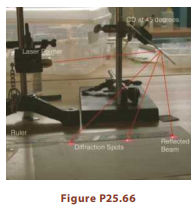A simple experiment can tell the difference between a CD and a higher-data-density DVD. The tracks of
Question:
A simple experiment can tell the difference between a CD and a higher-data-density DVD. The tracks of pits on an optical data disc can act like a grating when laser light is refl ected from its surface. Figure P25.66 shows a simple experimental confi guration to produce an interference pattern from a data disc using a red laser pointer (λ = 650 nm). In this particular experiment, the point on the disc struck by the laser is positioned 10 cm above the tabletop. When the disc is oriented at a 45° angle with respect to the vertical, the reflected laser light shows an interference pattern where the first maximum is 4.5 cm beyond the reflected beam (directly below the disc).
(a) What is the spacing of the tracks on the CD?
(b) If the CD is replaced with a DVD, will the first maximum in the interference pattern move closer to or farther from the reflected beam? Explain.
(c) The standard track spacing on a DVD is 0.74 mm. What is the distance from the reflected beam to the first interference maximum using this experimental configuration?

Step by Step Answer:

College Physics Reasoning and Relationships
ISBN: 978-0840058195
2nd edition
Authors: Nicholas Giordano





